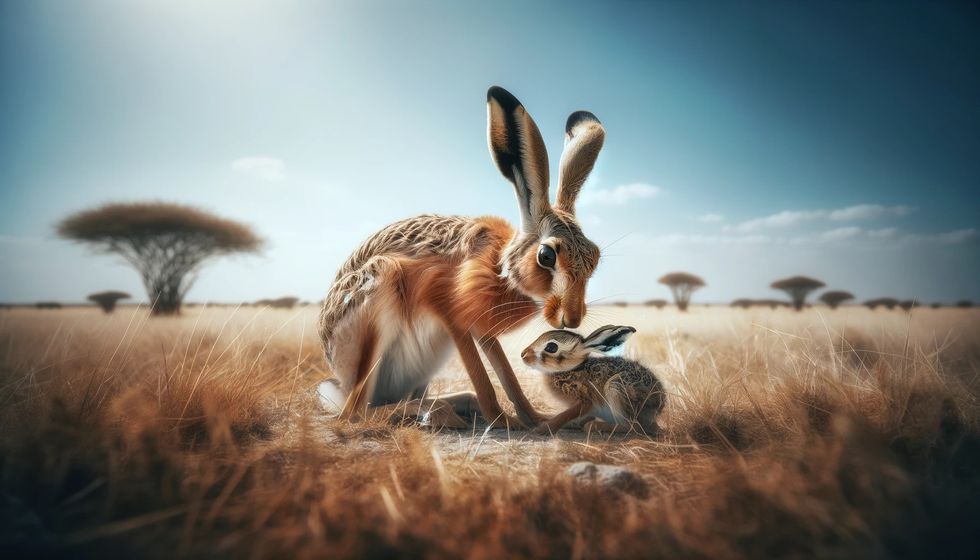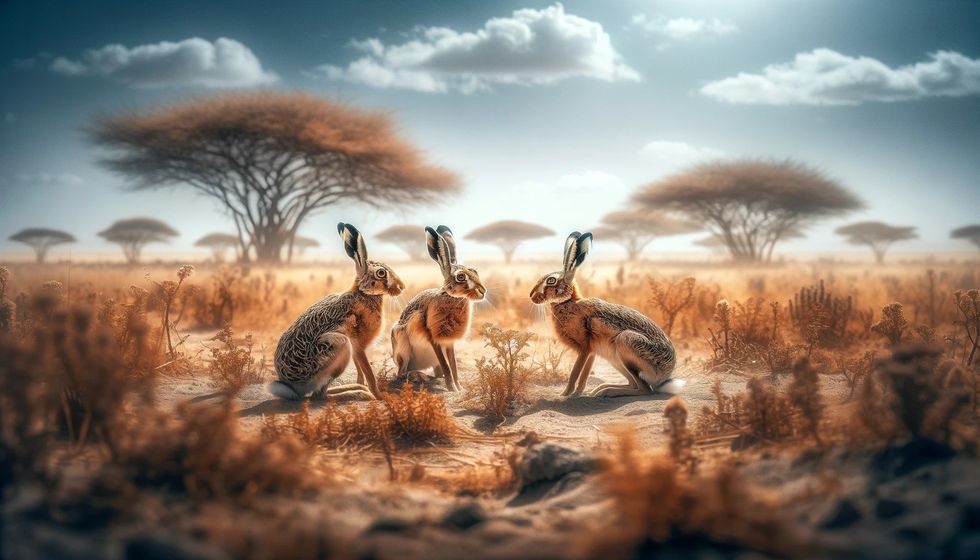The spring hare, formally recognized as Pedetes capensis and commonly referred to as the South African springhare, is an extraordinary mammal endemic to the semi-arid and arid landscapes of southwestern Africa. This unique species is highly adapted for life in such challenging environments, lacking abundant water and covered in thick, sandy soil perfect for their digging habits.
The spring hare's most notable feature is a pair of long, powerful hind legs that it uses to execute remarkable leaps, resembling a miniature kangaroo's mode of travel, which is why it garnered the common name 'spring hare'. Unlike other hopping creatures, their ability to bound great distances is not merely a mode of transportation but a survival technique.
These long hind legs, coupled with a proportionally elongated tail for balance, enable the animal to cover significant ground quickly, evading predators and swiftly moving between foraging sites. The animal exhibits a reddish-brown coat that aids in camouflaging it within the dry grasses and sandy terrain of its natural habitat. In these vast savannahs and open grasslands, the animal has become an iconic symbol of adaptation and agile movement.
Spring Hare Interesting Facts

What type of animal is a spring hare?
It is a small mammal known for its remarkable jumping ability and solitary nature.
What class of animal does it belong to?
It belongs to the class Mammalia, with its own family, Pedetidae, distinguishing it from other rodents.
How many spring hares are there in the world?
The exact numbers are unknown, but they are not considered endangered.
Where do they live?
They can be found burrowing into sandy soil across the grasslands and farmlands of Southern Africa, especially in South Africa, Botswana, Namibia, Angola, Zambia, Zimbabwe, southern Mozambique, Swaziland, and East Africa, Kenya.
What is their habitat?
They favor arid and semi-arid regions with soft, sandy soils, grasslands and farmlands, that allow them to dig extensive burrow systems for shelter.
Who do they live with?

Spring hares are generally solitary animals, although sometimes a female and her young may share a burrow.
How long does a spring hare live?
The life span of a spring hare in the wild varies, but they can live up to 12-15 years in the wild.
How do they reproduce?
They mate throughout the year. After a gestation period of approximately 77 days, the female gives birth to one or two well-developed young springhares.
What is their Conservation Status?
They are currently listed as Least Concern by the International Union for Conservation of Nature (IUCN).
Spring Hare Fun Facts
What do they look like?
Their appearance is characterized by reddish-brown fur covering their entire body, with a pale grey underbelly. They possess a thick muscular neck and long ears.
How cute are they?
Many find the spring hare's large eyes and perky ears endearing.
How do they communicate?

Primarily solitary, they communicate infrequently but use a variety of vocalizations, such as grunts, clicks, and high-pitched squeaks when they do.
How big is a spring hare?
The overall size of the animal can reach up to 14-17 in (35-45 cm).
How fast can a spring hare run?
Thanks to their muscular and well-developed hind legs, spring hares can reach impressive speeds when hopping.
How much does a spring hare weigh?
The body weight of an adult spring hare can vary between 6.6-8.8 lb (3-4 kg).
What are the male and female names of the species?
There are no specific names distinguishing between male and female.
What would you call a baby spring hare ?
In the absence of a unique designation, young spring hares are commonly referred to as 'juveniles' or simply as 'offsprings'.
What do they eat?

They are primarily herbivorous, and their diet includes grass roots, seeds, stems, and leaves.
Are they venomous?
No, they are not venomous.
Would they make a good pet?
Due to their need for large open spaces and specific dietary requirements, they are not recommended as pets.
Did you know...
Despite sharing some similarities with kangaroos, the springhare resembles a rodent more in its behavior and diet. Additionally, they have a unique defense mechanism where they can thump the ground with their hind feet, creating vibrations to ward off predators or signal danger.
They attain sexual maturity at about 5.5 lb (2.5 kg) rather than a particular age, which is when they begin to participate in breeding activities leading to the continuation of their species.
While spring hares are solitary creatures, they will engage in direct contact with others of their species solely during the breeding season or when a mother is with her offspring.
Large bushes within their ecosystem provide them with shelter and a vantage point to watch for predators or survey their surroundings.
Large owls are among the predators spring hares must evade during nocturnal foraging, highlighting the importance of their rapid, bouncing escape tactics.
Upon reaching reproductive maturity, they will reproduce and nurture their young, often within the safety of their subterranean nests.
Adapted to the harsh conditions of dry savannas, they use their digging prowess to create burrows and forage for the sparse vegetation available in these environments.
Though these animals are mainly nocturnal, they are occasionally active during the day, particularly when the weather is overcast and predator activity is low.
They maintain a varied diet of many plants, foraging extensively at night to feed on a variety of vegetation, including roots and tubers.
The complex burrow systems of this creatures are meticulously designed to prevent sand from collapsing in on them, ensuring safe havens against predators and the elements.
Of the extant species within their family, Pedetidae, they are notable for their adaptation to dry environments and their kangaroo-like leaping abilities.
The spring hare, often likened to a small kangaroo due to its large back legs and long hops, is a fascinating mammal native to the grasslands of Africa.
Among the natural predators of the spring hare are serval cats, agile hunters well-suited to catching these fast, leaping rodents.
A single animal may construct up to three burrows within its territory, ensuring multiple safe havens within its home range on the sandy plains.
Residing on the sandy plains of Southern Africa's dry regions, they use their powerful hind legs to navigate and their fore legs to dig burrows in this loose soil environment.
Among two extant species in the Pedetidae family, the animal distinguishes itself by its long tail and elongated hind limbs designed for jumping.
The burrow entry points created by them often have a circular shape and are strategically placed within their habitat to provide quick escape routes.
The distinctive black tip on their tail is often seen when they bound away, serving as a visual cue to conspecifics and a marker during their nocturnal activities.
The size of the animal varies from one individual to another, with their weight and body length adapted to optimize survival in their chosen habitats.
FAQs
What is the difference between a rabbit and a spring hare?
Although they share some superficial similarities, rabbits and spring hares are distinct in several ways. Spring hares belong to their own family, Pedetidae, and exhibit unique adaptations such as exceedingly long and powerful hind legs for leaping and a preference for arid environments.
Rabbits, which belong to the family Leporidae, are generally smaller, have shorter hind legs proportionate to their body, and are found in a variety of habitats. Furthermore, spring hares are solitary nocturnal animals, whereas rabbits can be diurnal or nocturnal and often live in social groups.
Are spring hares nocturnal?
Yes, they are primarily active at night, a behavior necessitated by the intense daytime heat of their natural habitats and the presence of diurnal predators. They seek refuge in burrows during the day, which offer protection and a cooler environment. At night, they come out to forage for a variety of plant materials, including grasses and roots.
The large eyes of the animal are a direct adaptation to their nocturnal way of life, granting them enhanced vision in the dim light of the African savannas, which is critical for identifying food sources and evading predators that also roam the night.
What makes the spring hare capable of its impressive leaps?
The animal possesses long, powerful hind legs and a robust muscular structure, particularly evident in its hindquarters and tail that provide balance. These adaptations enable them to perform significant leaps, which can be more than 6.6 ft (2 m) in a single bound, causing its movement to resemble that of a kangaroo.
How does the spring hare contribute to its ecosystem?
As herbivores, they play a critical role in grazing and thus maintaining local vegetation. Their digging behavior also contributes to soil aeration and composting, and their burrows provide shelters that can be used by other animals. Additionally, as a prey species, they support the food web as they can be a food source for predators.
Are they an endangered species?
They are not considered endangered and are listed as Least Concern by the International Union for Conservation of Nature (IUCN). This status indicates that their population faces no significant immediate threat across their range in Southern Africa.
Regular monitoring is essential to ensure that this status is maintained, especially given changes in land use and potential threats from agricultural expansion and hunting.
The spring hare, with its distinctive leaps and solitary habits, is a captivating creature of the African plains. Though they maintain a low profile, being chiefly nocturnal and solitary animals, their importance to the ecosystem, especially in controlling the growth of certain plants, cannot be understated.
As a resident of sandy environments, the spring hare has adapted to its habitat with remarkable traits and continues to thrive in the wilds of Southern Africa.
Related Articles Around the Web













